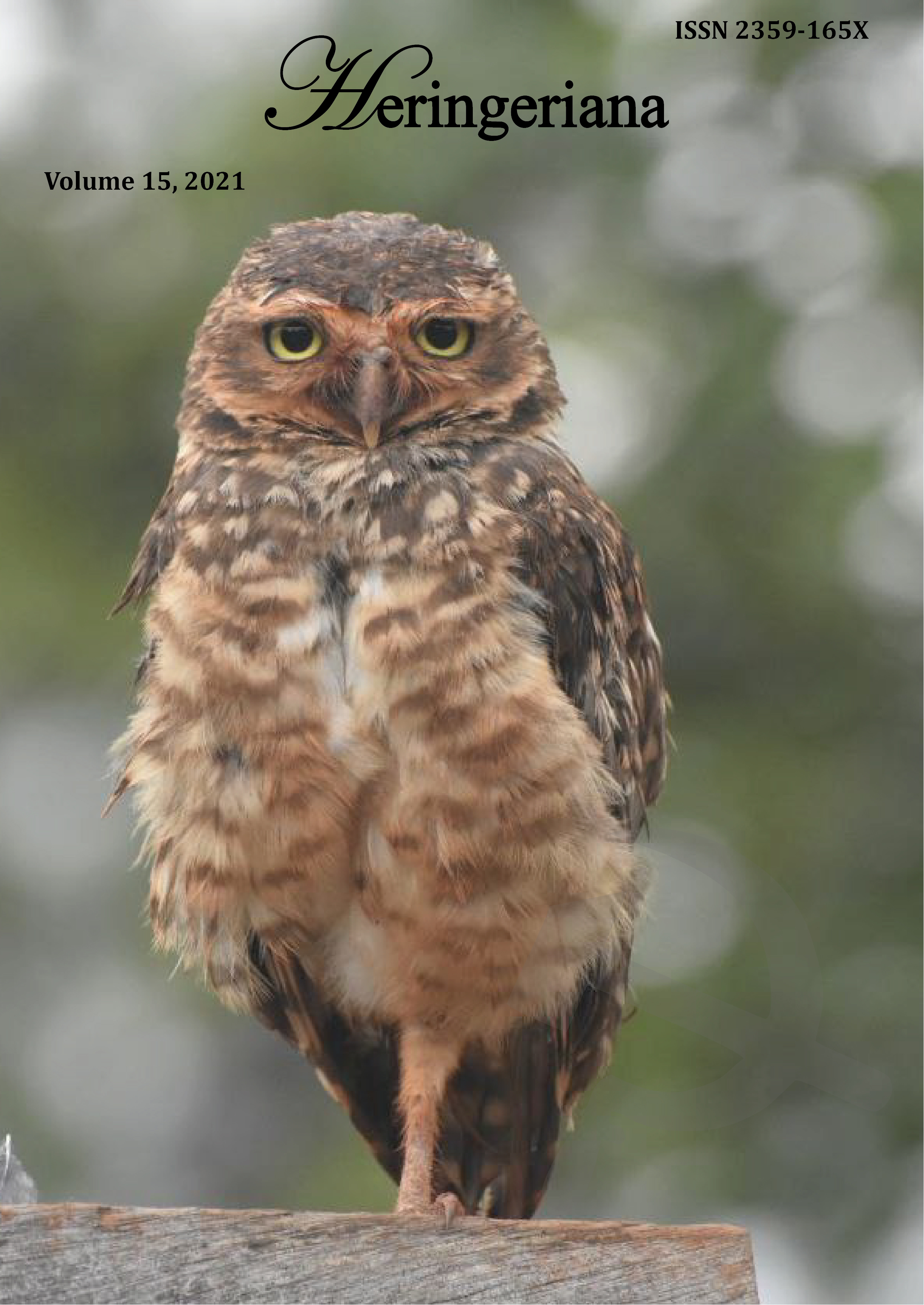Wing symmetry in wild drosophilids (Insecta, Diptera) is not affected by season in the Brazilian Cerrado
DOI:
https://doi.org/10.17648/heringeriana.v15i1.917941Keywords:
Brazil, environmental stress, fluctuating asymmetry, seasonal variationAbstract
The development of an organism is a controlled process, which can be disrupted by genetic or environmental stress. Although fluctuating asymmetry is widely used as an indicator of developmental instability, its effectiveness has been questioned due to the contradictory results produced by this technique which, at least in part, probably reflects methodological inappropriateness. Here, we investigated if wing asymmetry of drosophilids increases when they develop during the dry season in the Brazilian savanna, considered a stressful season for these insects. Using protocols designed to avoid methodological problems, we analysed the wings of Zaprionus indianus and three species of the genus Drosophila (D. mercatorum, D. simulans, and D. sturtevanti). There was no significative difference in wing asymmetry in any of the four species between the dry and rainy seasons. The similar wing asymmetry levels between seasons may mean that during the dry season drosophilids are submitted to strong natural selection and the asymmetric individuals have less chance of surviving. Alternatively, environmental drought may not affect the wing symmetry. Although our study added more data to the relationship between asymmetry and stress, this discussion seems to be far from being solved.
References
Ambo-Rappe, R., Lajus, D.L. & Schreider, M.J. (2008) Increased heavy metal and nutrient contamination does not increase fluctuating asymmetry in the seagrass Halophila ovalis. Ecological indicator 8: 100-103.
Anciães, M. & Marini, M.A. (2000) The effects of fragmentation on fluctuating asymmetry in passerine birds of Brazilian tropical forests. Journal of Applied Ecology 37: 1013-1028. https://doi.org/10.1046/j.1365-2664.2000.00554.x
Antipin, M. I. & Imasheva, A. G. (2001) Genetic Variability and Fluctuating Asymmetry of Morphological Traits in Drosophila melanogaster Reared on a Pesticide-Containing Medium, Russian Journal of Genetics, 37: 247–252. https://doi: 10.1023/A:1009000925144
Beasley, D.A.E., Bonisoli-Alquati, A. & Mousseau, T. A. (2013) The use of fluctuating asymmetry as a measure of environmentally induced developmental instability: A meta-analysis. Ecological Indicators 30: 218–226. https://doi.org/10.1016/j.ecolind.2013.02.024
Benítez, H. A. & Parra, L. E. (2011) Fluctuating asymmetry: A morpho-functional tool to measure development stability. International Journal of Morphology 29(4): 1459–1469. https://doi.org/10.4067/s0717-95022011000400066
Bjorksten, T.A., Pomiankowski, A. & Fowler, K. (2001) Temperature shock during development fails to increase the fluctuating asymmetry of a sexual trait in stalk-eyed flies. Proceedings of the Royal Society of London Series B-Biological Sciences 268(1475): 1503-1510. https://doi.org/10.1098/rspb.2001.1575
Bitner-Mathé, B.C. & Klaczko, L.B. (1999) Heritability, phenotypic and genetic correlations of size and shape of Drosophila mediopunctata. Heredity 83: 688-696. https://doi.org/10.1046/j.1365-2540.1999.00606.x
Clarke, G.M. (1995) Relationship between developmental stability and fitness: Application for conservation biology. Conservation Biology 9(1): 18-24.
Costa, R. N., Nomura, F. & Solé, M. (2017) Agropastoral activities increase fluctuating asymmetry in tadpoles of two neotropical anuran species. Austral Ecology 42: 801–809. https://doi.org/10.1111/aec.12502
Coster, G., van Dongen, S., Malaki, P., Muchane, M., Alcántara-Exposito, A., Matheve, H. & Lens, L. (2013) Fluctuating asymmetry and environmental stress: understanding the role of trait history. PLoS ONE 8(3): e57966. https://doi.org/10.1371/journal.pone.0057966
Dongen, S.V. (2006) Fluctuating asymmetry and developmental instability in evolutionary biology: past, present and future. Journal of Evolutionary Biology 19(6): 1727-1743. https://doi.org/10.1111/j.1420-9101.2006.01175.x
Freire-Maia, N. & Pavan, C. (1949) Introdução ao estudo da Drosófila. Cultus 1, 1-71.
Galego, L.G.C. & Carareto, C.M.A. (2010) Scenario of the spread of the invasive species Zaprionus indianus Gupta, 1970 (Diptera, Drosophilidae) in Brazil. Genetics and Molecular Biology 33(4): 767–773. https://doi.org/10.1590/S1415-47572010005000080
Hoffmann, A.A., Woods, R.E., Collins, E., Wallin, K., White, A. & McKenzie, J.A. (2005) Wing shape versus asymmetry as an indicator of changing environmental conditions in insects. Australian Journal of Entomology, 44(3): 233–243. https://doi.org/10.1111/j.1440-6055.2005.00469.x
Hosken, D.J., Blanckenhorn, W.U. & Ward, P.I. (2000) Developmental stability in yellow dung flies (Scathophaga stercoraria): fluctuating asymmetry, heterozygosity and environmental stress. Journal of Evolutionary Biology 13(6): 919-926. https://doi.org/10.1046/j.1420-9101.2000.00239.x
Imasheva, A.G. & Bubliy, O.A. (2003) Quantitative variation of four morphological traits in Drosophila melanogaster under larval crowding. Hereditas 138(3): 193-199. https://doi.org/10.1034/j.1601-5223.2003.01727.x
Jenkins, N.L. & Hoffmann, A. A. (2000) Variation in morphological traits and trait asymmetry in field Drosophila serrata from marginal populations. Journal of Evolutionary Biology 13(1): 113–130. https://doi.org/10.1046/j.1420-9101.2000.00149.x
Klaczko, L.B. & Bitner-Mathé, B.C. (1990) On the edge of a wing. Nature 346(6282): 321. https://doi.org/10.1038/346321a0
Klingenberg, C.P. (2015) Analyzing fluctuating asymmetry with geometric morphometrics: Concepts, methods, and applications. Symmetry 7(2): 843–934. https://doi.org/10.3390/sym7020843
Klingenberg, C.P. (2019) Phenotypic plasticity, developmental instability, and robustness: The concepts and how they are connected. Frontiers in Ecology and Evolution 7: 1–15. https://doi.org/10.3389/fevo.2019.00056
Koeberle, A.L., Arismendi, I., Crittenden, W., Leer, D. & Noakes, D.L.G. (2020) Fluctuating asymmetry of adult Chinook Salmon (Oncorhynchus tshawytscha) otoliths from wild and hatchery origins. Aquatic Ecology 54(1): 431–446. https://doi.org/10.1007/s10452-019-09733-0
Lens, L.S., Van Dongen, S., Kark, S. & Matthysen, E. (2002) Fluctuating asymmetry as an indicator of fitness: can we bridge the gap between studies? Biological Reviews 77(1): 27-38. https://doi.org/10.1017/S1464793101005796
Lessells, C.M. & Boag, P.T. (1987) Unrepeatable repeatabilities: A common mistake. The Auk 104(1): 116-121. https://doi.org/10.2307/4087240
Manfrin, M.H., Prado, P.R.R. & Sene, F.M. (1997) Analysis of sound components of sexual courtship of two subspecies of Drosophila mercatorum (Diptera, Drosophilidae). Revista Brasileira de Biologia 57: 349-355.
Menezes, B.F., Vigoder, F.M., Peixoto, A.A., Varaldi, J., & Bitner-Mathé, B.C. (2013) The influence of male wing shape on mating success in Drosophila melanogaster. Animal Behaviour, 85(6): 1217-1223
Markow, T.A. (1995) Evolutionary Ecology and Developmental Instability. Annual Review of Entomology 40: 105-120. https://doi.org/10.1146/annurev.en.40.010195.000541
Mata, R.A., McGeoch, M. & Tidon, R. (2010a) Drosophilids (Insecta, Diptera) as tools for conservation biology. Natureza & Conservação 8(1): 60–65. https://doi.org/10.4322/natcon.00801009
Mata, R.A., Tidon, R., Côrtes, L.G., de Marco, P. & Diniz-Filho, J.A.F. (2010b) Invasive and flexible: Niche shift in the drosophilid Zaprionus indianus (Insecta, Diptera). Biological Invasions 12(5): 1231–1241. https://doi.org/10.1007/s10530-009-9542-0
Mata, R.A. & Tidon, R. (2013) The relative roles of habitat heterogeneity and disturbance in drosophilid assemblages (Diptera, Drosophilidae) in the Cerrado. Insect Conservation and Diversity 6(6): 663–670. https://doi.org/10.1111/icad.12020
Mata, R.A., Valadão, H. & Tidon, R. (2015) Spatial and temporal dynamic of drosophilids larval assemblages associated to fruits. Revista Brasileira de Entomologia 59(1): 50–57. https://doi.org/10.1016/j.rbe.2015.02.006
Moller, A.P. & Swaddle, J.P. (1997) Asymmetry, developmental stability and evolution. Great Britain: Oxford University Press, 304 pp.
Mohr, S.E. (2018) First in fly: Drosophila research and Biological Discovery. Harvard University Press, 272 pp.
Oliveira, P.S. & Marquis, R.J. (2002) The Cerrados of Brazil. Ecology and natural history of a Neotropical savanna. New York: Columbia University Press, 450 pp.
Palmer, A.R. (1994) Fluctuating asymmetry analyses: A primer. In: Markow, T.A. (Ed.) Developmental instability: its origins and evolutionary implications. Kluwer, Dordrecht, Netherlands. pp. 335-364.
Palmer, A.R. & Strobeck, C. (1986) Fluctuating asymmetry - measurement, analysis, patterns. Annual Review of Ecology and Systematics 17: 391-421. https://doi.org/10.1146/annurev.es.17.110186.002135
Palmer, A.R. & Strobeck, C. (1992) Fluctuating asymmetry as a measure of developmental stability: Implications of non-normal distributions and power of statistical tests. Acta Zoologica Fennica 191: 55-70.
Pertoldi, C. & Kristensen, T.N. (2015) A new fluctuating asymmetry index, or the solution for the scaling effect? Symmetry 7(2): 327–335. https://doi.org/10.3390/sym7020327
Pinheiro, F., Diniz, I.R., Coelho, D. & Bandeira, M.P.S. (2002) Seasonal pattern of insect abundance in the Brazilian Cerrado. Austral Ecology 27(2): 132-136. https://doi.org/10.1046/j.1442-9993.2002.01165.x
Polak M., Opoka, R. & Cartwright, I.L. (2002) Response of fluctuating asymmetry to arsenic toxicity: support for the developmental selection hypothesis. Environmental Pollution 118(1): 19-28. https://doi.org/10.1016/S0269-7491(01)00281-0
Powell, J.R. (1997) Progress and Prospects in Evolutionary Biology: The Drosophila Model. Oxford University Press, New York, 580 pp.
Ribeiro, J.F. & Walter, B.M.T. (1998) Fitofisionomias do Bioma Cerrado. In: Sano, S.M. & Almeida, S.P. (Eds.) Cerrado: ambiente e flora. Planaltina: EMBRAPA-CPAC, pp. 89-166.
Roque, F., Mata, R.A. & Tidon, R. (2013) Temporal and vertical drosophilid (Insecta; Diptera) assemblage fluctuations in a neotropical gallery forest. Biodiversity and Conservation 22(3): 657–672. https://doi.org/10.1007/s10531-013-0433-4
Roque, F., Mencarini, L., Leão, B.F.D., Delgado, M.N. & Tidon, R. (2016) Three new records of drosophilids for the Brazilian Savanna. Drosophila Information Service 99: 2015–2016.
Sene, F.M., Val, F.C., Vilela, C.R. & Pereira, M.A.Q.R. (1980) Preliminary data on the geographical distribution of Drosophila species within morphoclimatic domains of Brazil. Papéis Avulsos de Zoologia 33: 315-326.
Soto, I.M., Carreira, V.P., Soto, E.M. & Hasson, E. (2008) Wing morphology and fluctuating asymmetry depend on the host plant in cactophilic Drosophila. Journal of Evolutionary Biology 21(2): 598–609. https://doi.org/10.1111/j.1420-9101.2007.01474.x
Tidon, R. (2006) Relationships between drosophilids (Diptera, Drosophilidae) and the environment on two contrasting tropical vegetations. Biological Journal of the Linnean Society 87(2): 233-247. https://doi.org/10.1111/j.1095-8312.2006.00570.x
Tidon, R., Leite, D.F. & Leão, B.F.D. (2003) Impact of the colonisation of Zaprionus (Diptera, Drosophilidae) in different ecosystems of the Neotropical region: 2 years after the invasion. Biological Conservation 112(3): 299-305. https://doi.org/10.1016/S0006-3207(02)00322-1
Tidon-Sklorz, R. & Sene, F.M. (1999) Diptera: Drosophila. In: Brandão, C.R.F. & Cancello, E.M. (Eds.) Biodiversidade do Estado de São Paulo: I síntese do conhecimento ao final do século XX. São Paulo, vol. 5, pp. 245-261.
Trotta, V., Calboli, F.C.F., Garoia, F., Grifoni, D., & Cavicchi, S. (2005) Fluctuating asymmetry as a measure of ecological stress in Drosophila melanogaster (Diptera: Drosophilidae). European Journal of Entomology 102(2): 195–200. https://doi.org/10.14411/eje.2005.031
Vangestel, C. & Lens, L. (2011) Does fluctuating asymmetry constitute a sensitive biomarker of nutritional stress in house sparrows (Passer domesticus)? Ecological Indicators 11(2): 389–394. https://doi.org/10.1016/j.ecolind.2010.06.009
Vilela, C.R. (1983) A revision of the Drosophila repleta species group (Diptera, Drosophilidae). Revista Brasileira de Entomologia 27: 1-114.
Vilela, C.R. (1999) Is Zaprionus indianus Grupta, 1970 (diptera, drosophilidae) currently colonizing the Neotropical region? Drosophila Information Service 82: 37-39.
Vishalakshi, C., & Singh, B.N. (2009) Fluctuating asymmetry in hybrids of sibling species, Drosophila ananassae and Drosophila pallidosa, is trait and sex specific. Journal of Heredity 100(2): 181–191. https://doi.org/10.1093/jhered/esn094
Wolda, H. (1988) Insect seasonality: why? Annual Review of Ecology and Systematics 19: 1–18. https://doi.org/10.1146/annurev.ecolsys.19.1.1
Downloads
Published
How to Cite
Issue
Section
License
Copyright (c) 2021 Luciana Costa Nascimento, Francisco Das Chagas Roque Machado, Rosana Tidon

This work is licensed under a Creative Commons Attribution 4.0 International License.
By submitting, the authors declare that they have not submitted the work to another journal and agree to have their article published under a Creative Commons Attribution 4.0 International BY License (CC BY 4.0), which means that authors retain ownership of the copyright but anyone can use the published content provided the original authors and source are cited. The scientific, orthographic and grammatical content is the full responsibility of the authors.








